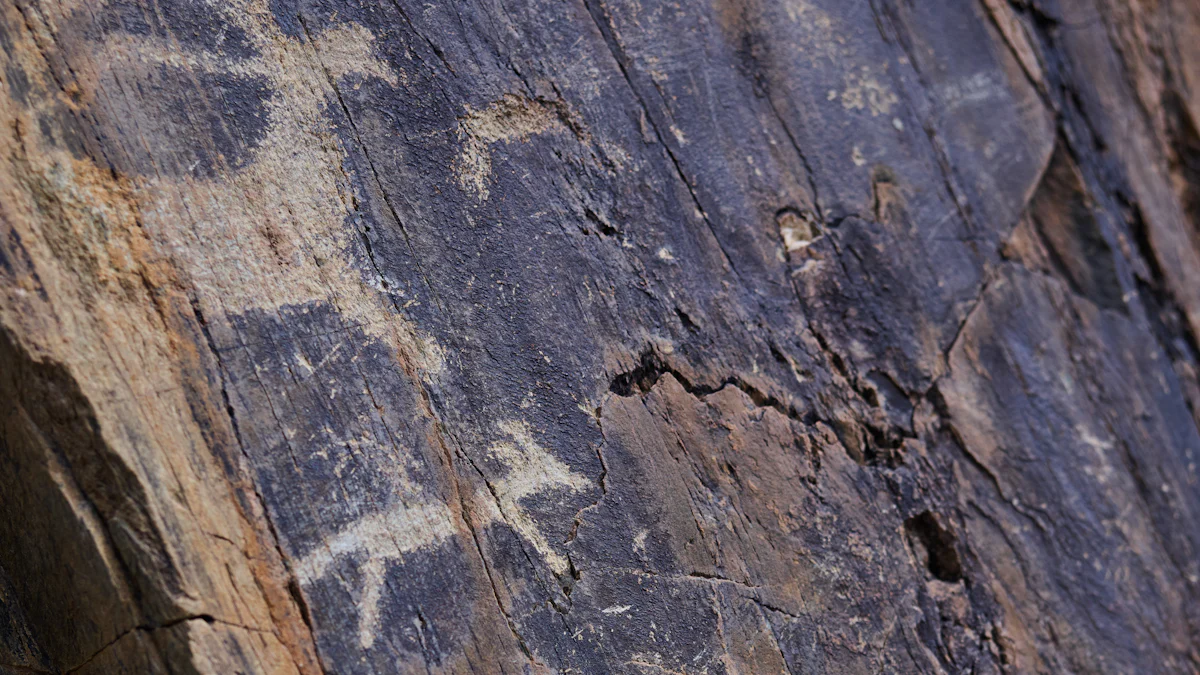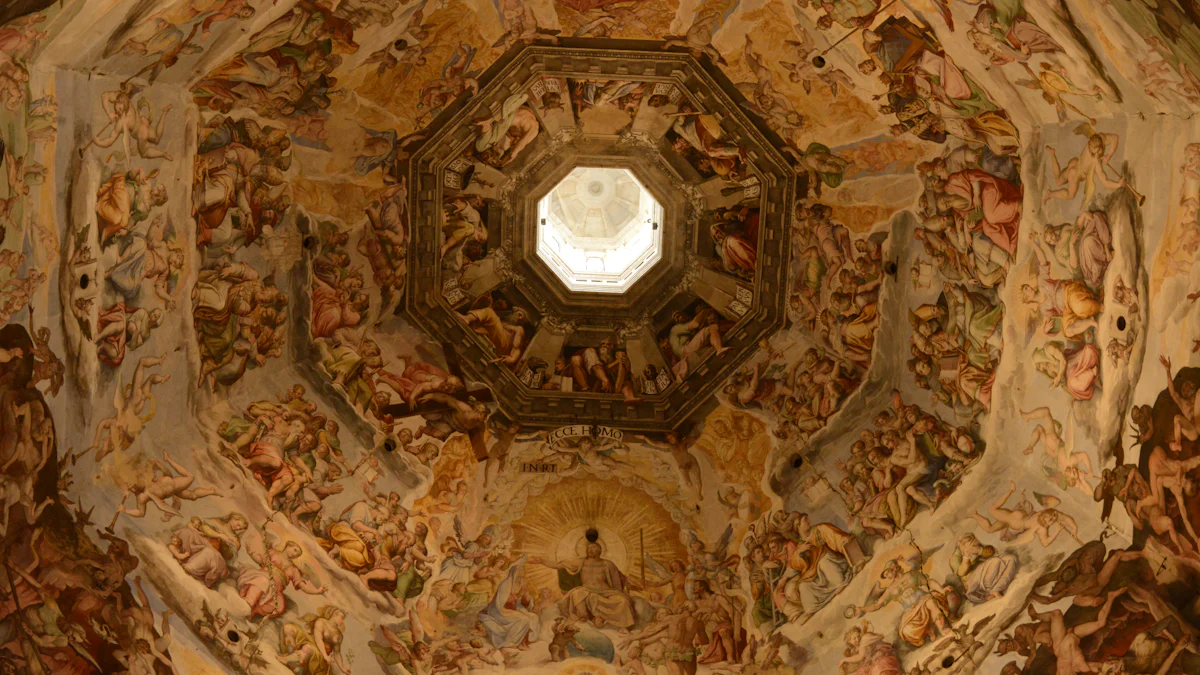Art: The Definitive Visual Guide

Art holds a crucial place in human history and culture. It mirrors societal shifts and has a profound influence on the world. In 2022, the economic impact of arts and cultural industries hit a record high, contributing 4.3% of the GDP, or $1.1 trillion, to the U.S. economy. This significant contribution underscores art's importance in both historical and economic contexts. The evolution of art highlights its visual allure and historical significance, providing insights into human creativity and expression throughout history.
Prehistoric Art

Origins and Influences
Prehistoric art marks the dawn of human creativity. The earliest known examples include cave paintings and petroglyphs. These ancient artworks provide a glimpse into the lives and beliefs of early humans.
Cave Paintings
Cave paintings serve as a testament to early human expression. The Lascaux cave paintings, created around 15,000 BC, depict animals with astonishing detail and expressiveness. The Altamira paintings, dating from the same period, showcase animals with impressive mastery of technique. The Bhimbetka rock shelters, containing over 600 paintings, span the prehistoric Paleolithic and Mesolithic periods. These sites reveal scenes of daily life and animals in a vivid and dynamic style.
Petroglyphs
Petroglyphs represent another form of prehistoric art. These carvings on rock surfaces often depict animals, humans, and abstract symbols. The Chauvet-Pont-d’Arc Cave contains some of the best-preserved figurative cave paintings in the world. These artworks highlight the skill and creativity of early humans.
Characteristic Styles and Techniques
Prehistoric art exhibits unique styles and techniques. Early artists utilized available materials and incorporated symbolism and themes into their works.
Materials Used
Artists in prehistoric times used natural materials. Charcoal, ochre, and other minerals provided pigments for cave paintings. Stone tools enabled the creation of petroglyphs. These materials allowed artists to produce enduring works of art.
Symbolism and Themes
Symbolism played a crucial role in prehistoric art. Animals often appeared in cave paintings, representing important aspects of daily life. Human figures and abstract symbols conveyed spiritual beliefs and cultural values. These themes offer insight into the thoughts and experiences of early humans.
Ancient Art
Egyptian Art
Iconography
Egyptian art holds a unique place in history. The art often features gods, pharaohs, and daily life scenes. Hieroglyphics accompany many artworks, providing context and meaning. The use of symbols like the ankh and scarab beetle represents life and protection. Egyptian motifs have influenced Western art, especially during the Egyptian Revival period. This revival saw Egyptian designs applied to decorative objects.
Techniques and Materials
Egyptian artists used a variety of materials. Stone, wood, and metal formed the basis of sculptures and structures. Artists employed gold and precious stones for jewelry and decoration. Paintings often appeared on papyrus or walls. The use of vibrant colors like blue, green, and red characterized Egyptian art. Techniques included carving, painting, and inlay work. These methods created enduring and iconic pieces.
Greek and Roman Art
Sculpture and Architecture
Greek art introduced monumental stone sculptures. Early Greek statues show Egyptian influence in their rigid poses. Over time, Greek sculptors developed more naturalistic forms. The Parthenon exemplifies Greek architectural mastery. Roman art borrowed heavily from Greek traditions. Romans excelled in realistic portraiture and grand architecture. The Colosseum stands as a testament to Roman engineering and design.
Influence on Western Art
Greek and Roman art shaped Western art history. The Renaissance saw a revival of classical ideals. Artists studied ancient sculptures to learn proportion and anatomy. Greek and Roman themes appear in paintings and sculptures throughout Europe. The impact of these ancient civilizations continues to inspire modern artists. Their contributions to art and architecture remain significant today.
Medieval Art
Byzantine Art
Religious Themes
Byzantine art thrived during the Eastern Roman Empire. Artists focused on religious themes, portraying icons like Christ, the Virgin Mary, and saints. Gold backgrounds added a divine quality to these works. The flatness and lack of dimensionality characterized Byzantine paintings. This style aimed to inspire devotion rather than realism.
Mosaics and Frescoes
Mosaics and frescoes became prominent in Byzantine art. Artists used small pieces of colored glass or stone to create intricate designs. These mosaics adorned church walls and ceilings, depicting biblical stories. Frescoes, painted directly onto wet plaster, also illustrated religious narratives. Both techniques emphasized spiritual messages over physical realism.
Gothic Art
Architecture
Gothic architecture emerged in the 12th century. Builders designed structures with pointed arches and flying buttresses. Large rose windows allowed light to flood into cathedrals. This style aimed to reach for the sky, symbolizing divine aspiration. Gothic architecture broke away from the Romanesque style, embracing more naturalistic and elegant forms.
Stained Glass
Stained glass became a hallmark of Gothic art. Artisans crafted windows with bright colored glass, creating luminous scenes. These windows depicted religious stories and saints, enhancing the spiritual atmosphere. The attention to detail in stained glass reflected the Gothic obsession with ornamentation. This influence extended to Renaissance art, shaping its religious works.
Renaissance Art

Key Figures and Works
Leonardo da Vinci
Leonardo da Vinci stands as a pivotal figure in Renaissance art. His works reflect a deep understanding of the human body and nature. Renaissance Art Expert highlights da Vinci's influence on other artists. The Mona Lisa and The Last Supper showcase his mastery of technique and emotion. These paintings remain iconic in art history. Da Vinci's sketches reveal his scientific curiosity and artistic skill. His studies of anatomy contributed to more realistic representations in art.
Michelangelo
Michelangelo's contributions to Renaissance art are monumental. His sculptures and paintings display unparalleled skill and creativity. The David sculpture exemplifies his ability to capture human form and emotion. Michelangelo's work on the Sistine Chapel ceiling remains a masterpiece of religious art. Renaissance Artists emphasize his impact on future generations. His use of dynamic poses and expressive figures set new standards in art. Michelangelo's legacy continues to inspire artists worldwide.
Techniques and Innovations
Perspective
Renaissance artists revolutionized art with the use of perspective. This technique allowed for more realistic and three-dimensional scenes. Renaissance Artists note the importance of linear perspective in creating captivating paintings. Artists like da Vinci and Raphael mastered this method. Perspective transformed the way viewers experienced art. Buildings, landscapes, and figures gained depth and realism. This innovation marked a significant shift in art history.
Use of Light and Shadow
The use of light and shadow became a hallmark of Renaissance art. Artists employed chiaroscuro to create contrast and drama in their works. This technique enhanced the emotional impact of paintings. Renaissance Art Expert explains how artists drew inspiration from Byzantine art. Renaissance painters explored humanism and nature through light and shadow. This approach added depth and dimension to their compositions. The interplay of light and dark remains a powerful tool in art today.
Baroque and Rococo
Baroque Art
Dramatic Use of Light
Baroque art emerged in the late 16th century. Artists used dramatic lighting to create intense contrasts. This technique, known as chiaroscuro, added depth and emotion. Caravaggio mastered this approach, influencing many others. Paintings often depicted religious themes with vivid realism. The use of light emphasized spiritual moments and divine presence.
Emotional Intensity
Baroque art conveyed strong emotions. Artists focused on movement and tension in their compositions. Sculptures and paintings captured dramatic scenes with dynamic poses. Bernini's sculptures exemplified this intensity. The art aimed to engage viewers emotionally. Religious subjects dominated, reflecting the church's influence during this period.
Rococo Art
Ornate Details
Rococo art developed in the early 18th century. Artists embraced ornate details and intricate designs. The style featured elegant curves and playful motifs. Interiors of palaces showcased this lavish decoration. Furniture and decorative arts reflected the same aesthetic. Rococo art represented a shift from Baroque's grandeur to lighter themes.
Pastel Colors
Rococo artists favored pastel colors. Soft hues created a sense of whimsy and grace. Paintings often depicted leisurely scenes and secular themes. Fragonard and Watteau captured moments of romance and leisure. The art celebrated beauty and pleasure in everyday life. Rococo marked a departure from Baroque's dramatic symbolism.
Modern Art
Impressionism
Key Artists
Impressionism emerged in the late 19th century. Artists like Claude Monet, Edgar Degas, and Pierre-Auguste Renoir led this movement. These artists focused on capturing light and color. Their work often depicted everyday scenes. The use of loose brushwork became a hallmark of their style. Impressionists painted outdoors to capture natural light. This approach differed from traditional studio painting.
Techniques and Themes
Impressionist artists used short, thick strokes of paint. This technique created a sense of movement. Colors appeared vibrant and unblended. Artists avoided black for shadows, using complementary colors instead. Common themes included landscapes, cityscapes, and social gatherings. Impressionism emphasized the artist's perception of a moment. This focus on personal experience marked a shift in art history.
Abstract Art
Pioneers of Abstraction
Abstract art gained prominence in the early 20th century. Artists like Wassily Kandinsky and Piet Mondrian pioneered this style. They moved away from realistic representation. Abstract artists explored shapes, colors, and forms. Clement Greenberg, a Marxist art critic, praised abstract expressionism. He valued its aesthetic purity and form. Critics like Roger Fry and Clive Bell supported abstract art. They appreciated its imaginative qualities.
Impact on Contemporary Art
Abstract art influenced many contemporary movements. Artists embraced freedom from traditional constraints. This approach allowed for diverse expressions. Abstract techniques appear in modern digital art. The focus on form and color continues to inspire artists today. Abstract art's legacy remains significant in the art world.
Contemporary Art
Postmodernism
Characteristics
Postmodernism challenges traditional ideas about art. Artists use irony and playfulness to question established norms. This movement embraces a mix of styles and mediums. Postmodern art often includes references to popular culture and history. The use of pastiche and parody is common. Artists aim to blur the lines between high and low art.
Notable Artists
Several artists have shaped postmodernism. Jeff Koons uses everyday objects in his work. His sculptures often reflect consumer culture. Cindy Sherman explores identity through photography. Her self-portraits challenge gender roles and stereotypes. Damien Hirst creates provocative installations. His work often examines themes of life and death.
Digital Art
New Media
Digital art uses technology as a creative tool. Artists employ computers, software, and digital devices. This form of art includes digital painting, video, and animation. New media allows for interactive experiences. Viewers can engage with art in dynamic ways. Digital platforms offer artists new opportunities for expression.
Influence on Art World
Digital art has transformed the art world. Artists reach global audiences through online platforms. Social media provides exposure and interaction. Digital tools enable innovative techniques and styles. The accessibility of technology democratizes art creation. Digital art continues to evolve and inspire future generations.
Art shapes and inspires society, leaving a profound impact on culture. The evolution of art highlights its power to evoke emotions and challenge paradigms. This guide offers a comprehensive resource for understanding art's rich history and diverse expressions. Art serves as a catalyst for social change, promoting empathy across cultural divides. Readers can explore the endless possibilities within the art world. Delving deeper into art reveals its potential to illuminate history and foster understanding.
See Also
Armored Vehicles: A Comprehensive Illustrated History
Visual Guide to the History of Britain and Ireland
Visual Encyclopedia of American History

